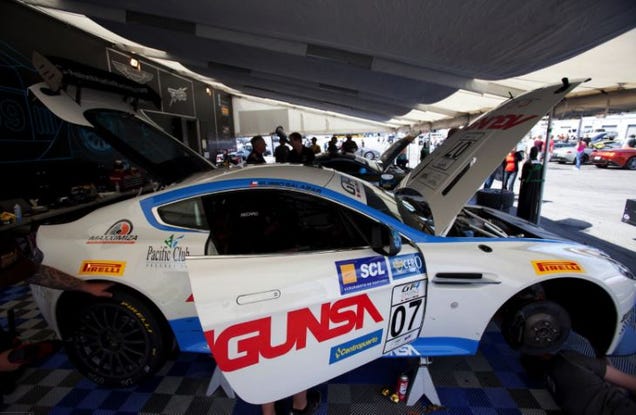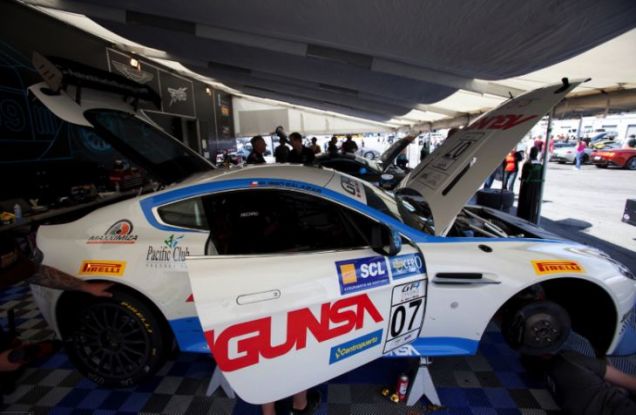
I knew it was coming. That feeling of utter helplessness, of panic. I was sweating profusely. The question of “if” was gone, replaced by “when”—a question that was to be answered about 15 seconds later. I zipped down my race suit to act as a sick bag, lifted my helmet as best I could, and prepared for the inevitable. This was among the lowest moments of my life.
And it would only get worse.
I was at Mazda Raceway Laguna Seca, there to produce a video review of an Aston Martin Vantage GT4. The day had gone well. Kevin Buckler, the boss of TRG-Aston Martin Racing, had assigned me former-F1 driver Eliseo Salazar’s car—a machine he was racing that very weekend during Aston’s GT4 Challenge.
Advertisement
I’d been granted one brief session. Two camera guys were accompanying me, Joel Villarreal and Ricky Montalvo. Gathering enough footage would be tough given the time restraints, but we did our best.
Ten laps went by. I felt comfortable in the car immediately (it’s basically just a lightened V8 Vantage with slick tires and racing suspension). As always, Laguna Seca was a delight; the Corkscrew as impressive as ever. I returned to the pits, satisfied. Salazar came over to chat. We discussed the car’s handling, gesticulating wildly with our hands—a language only racers comprehend. Soon, Villarreal and Montalvo returned.
Sponsored
“How was the footage?” I asked.
“Good,” I was told. “But we don’t have much.”
I wandered over to Buckler to plead for another session. This was during a race weekend and in a car that was actually competing. It was a big ask.
“I’ve got an idea,” Buckler said. “Would you be willing to ride passenger seat with a friend of mine?”
Advertisement
“I suppose,” I said. “But I kind of need the footage of me driving.”
“You drive two hot laps, then switch and let him drive,” Buckler replied. “You’re the coach. He’s experienced—a steady driver, very safe.”
I thought about this for a moment.
I hate riding passenger seat, but then I did need the footage. Reluctantly, I agreed, encouraged only by the words “experienced,” “steady” and “safe.”
Off to lunch. A feast of oil-soaked burritos, quesadillas and tacos—served with more burritos and quesadillas and tacos. We lived like kings, the TRG hospitality tent our luxurious palace. Access remained part of the $35,000 price tag a regular driver must fork out each weekend.
Full and content, I suited back up, readying for my final run. I was given an external microphone to slide between my head and helmet. It functioned as an intercom, enabling me to talk to my new student.
I honestly don’t remember his name; my mind, presumably, choosing to block out the memory. But he was very pleasant, very friendly. I thrashed the GT4 around Laguna Seca, kicking the tail out on occasions, all the while narrating my way around.
“Get your braking done early,” I said. “Look for the lone tree in front as a reference, and then squeeze back to power.”
After two hot laps, we swapped positions. The passenger seat was considerably lower than the driver’s, and the seat belts—rather worryingly—wouldn’t tighten, leaving about three inches of slack.
At this precise moment, I had a decision to make. Any sane human would have walked. An Aston Martin Vantage GT4 is no joke, and riding shotgun with a random stranger with non-functioning seat belts was perilous. This was only months after the tragic death of racer Sean Edwards.
I should have known better. It was a stupid decision, one I regret. And yet I pressed on regardless.
“So how many times have you driven here,” I asked, as we drove down pit lane. The man was not wearing a race suit or boots, just a pair of jeans and a yellow polo shirt.
“Never,” he replied. “This is my first time ever on a racetrack, I’m so excited!”
Alarm bells rang. Again.
This man had never been on a track before, and we were aboard a slick-tired GT4 race car with belts that don’t fit—on Laguna Seca where blind crests catch out even the best. But he was “steady,” I was told. Surely we’d just plod around, never using the full 450 horsepower on tap.
I couldn’t have been more wrong. We were weaving left and right on the straights, barely holding it between the white lines. The Corkscrew was the one place we did go straight, bouncing over the gravel—you know, effectively crashing. Worse, he didn’t even realize that we’d ventured off-road.
After three terrifying laps we pitted. I felt sick. Very sick.
Buckler popped his head through the driver’s window: “Hey, we’ve still got 15 minutes left,” he said. “Wanna do three more?”
Before I’d had time to think we were back on track. I screamed down the intercom begging for him to brake earlier, but the man simply didn’t listen. I couldn’t predict when he would stab the brakes, launching me forward like a bucking bronco. He’d then stomp on the gas violently, swerving down the straight like a possessed kitten chasing a fly.
Two more laps went by. The sickness became acute, and I stopped talking.
“Keep coaching me,” he pleaded.
Being British and polite, I continued, once again howling for him to brake more smoothly. I made it to the checkered flag and told him to back it down. But it was too late. That churning feeling deep within the pit of my stomach had risen up into my throat. Every time I swallowed I could taste the guacamole and beef, curdled like sour milk on a warm summer’s day. This was it. The end.
The thought when I unzipped my suit was to contain the sick efficiently. Maybe I could escape this predicament without anyone knowing? Over the crest through turn one, it arrived, thunderously, like a fountain of Mexican-made lava. It was worse than I had expected, exploding through my visor and onto the windshield.
My student, as per usual, hadn’t noticed. He kept stabbing at the brake viciously, then accelerating, on and off and on and off. “How to I brake?” he kept saying. “Like this, or like this? Or maybe like this?”
I couldn’t stop projecting, spewing chunks as if Niagara Falls was exploding from out of my mouth. It was deeply troubling, made worse by the thought that my student could hear me through the intercom, retching uncontrollably while still attempting to answer his ridiculous braking question.
It was half a lap before my stomach stopped contacting. I was out of breath. I looked at my surroundings to determine the damage. My white suit was now orange, my visor dripping. The car’s dashboard looked like a graffiti artist had lost his shit and gone mad.
“What about Eliseo,” I thought.
The reality of what had happened truly hit home once we stopped in pit lane. Around 40 people were waiting and watching. I sheepishly ushered a mechanic to come over. Having now finally figured out what that dreadful smell was, my student swiftly vanished—never even saying thank you.
The mechanic, though, was awesome: “Don’t worry,” he said. “It’s fine, I’ll get you some towels.”
I called over my producer, Villarreal. He had still been recording, but something told him to put the camera down—a decision, to this day, he regrets.
The smell, he later told me, was evident from 30 feet away: “When I got to the car, I’d never seen anything like it,” he recalls. “It was the most brilliantly disgusting mess I’ve ever seen, and it took all my strength not to laugh at you.”
I had tried to mop up what I could using the two white towels, as had the poor mechanic. Still, the roll cage was dripping with vomit. The seats were distressing; the puddle in the foot well deep enough to entirely submerge both my race boots.
Aston Martin GT3 racer Christina Nielsen wandered over, doubtlessly assuming I was engaging in profound statements about the car’s performance. She looked at me, horrified. And then left.
Still in the car, I jiggled my suit down to my waist, using the helmet to shield my now rainbow-colored top. There, I made a run from the car’s cockpit, over the pit wall, and as far from the bewildered spectators as possible. I scampered to my rental car, where I striped butt naked and used bottles of water to attempt some form of suit cleaning prior to shoving it in my suitcase. It was as if I had undergone a scandalous college hazing ritual.
Naked, afraid and ashamed, I pulled on some clean clothes, got into the car and left—without so much of a goodbye.
I was annoyed. Annoyed that I’d even agreed to ride passenger seat; annoyed that I did so despite knowing the belts didn’t fit; annoyed that I didn’t put an end to the misery after our first run; and annoyed that this chap drove so alarmingly I ruined Salazar’s (a veteran of 37 Formula One Grand Prix, six 24 Hours of Le Mans and seven Indy 500s) GT4 race car—a machine he had to drive 30 minutes later.
And I was annoyed that we Brits are so damn polite.
I saw Salazar a year later in Indianapolis for a vintage pro/am we were both racing. He never said a thing. I always wondered, did he know? He must have. I mean, how could he not?
I often feel bad about what happened. He drove that bespattered GT4 for a further three days, the lingering whiff of curdled burrito etched into his seat.
Update: He knew.
@Alex_Lloyd is Head of Content at Beepi, a radically transparent and easy way to buy, sell and lease cars online. A racing driver who competed in the Rolex 24 at Daytona twice and the Indianapolis 500 four times, his column Three Wide is about the culture of speed.















